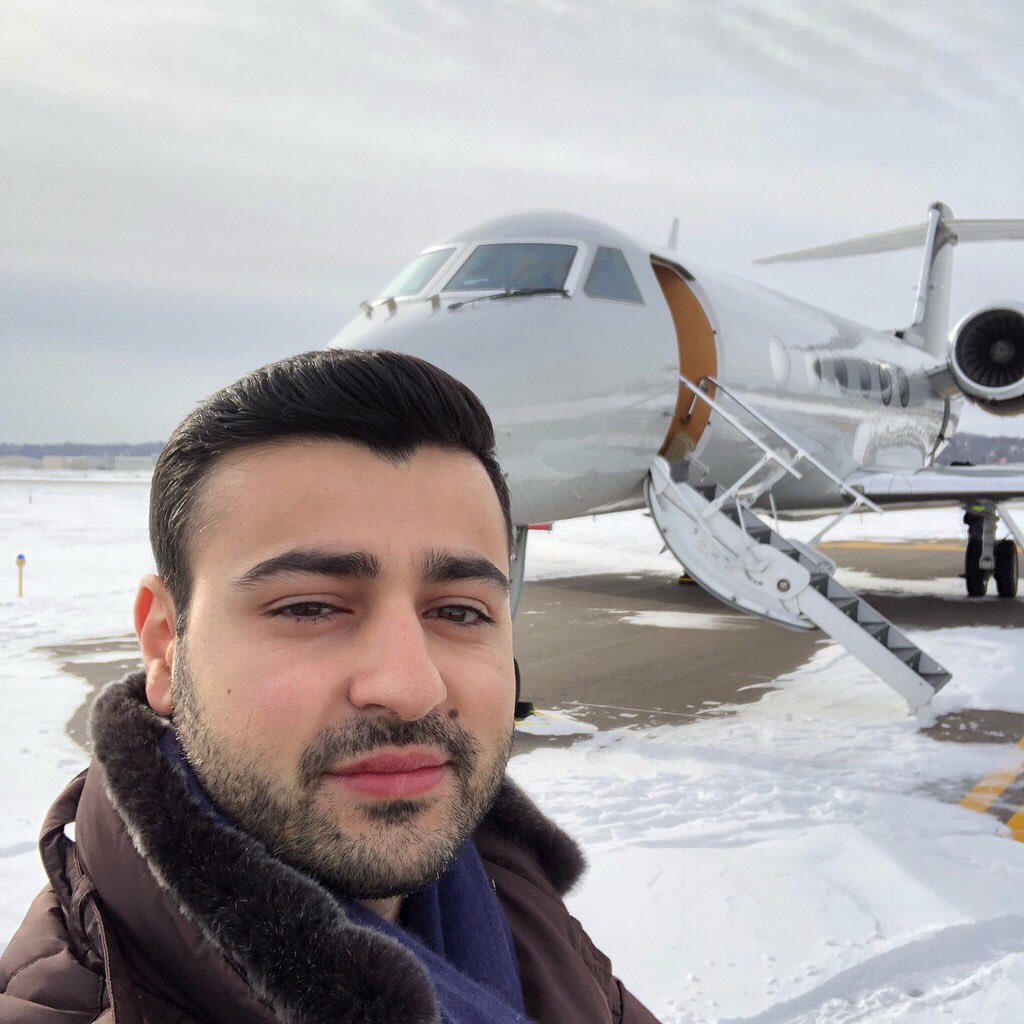Sergey Petrossov and JetSmarter are Flying High

Sergey Petrossov is the Founder and CEO of JetSmarter, an app that makes private jet travel affordable and straightforward. The serial entrepreneur was listed as one of Forbes’ 30 under 30 for 2016 and named one of South Florida’s Top Working Professionals. We recently sat down for a chat with Sergey.
Could you go a bit into the details of your business? What is JetSmarter all about?
The fundamental idea behind JetSmarter came to me sometime in 2009, when I realized that the average airplane is only flying about 200 hours a year when they could be flying close to 1,200 hours. We figured that if we bought up this idle time and broke it up by the seats, we could lower the cost significantly. Making private travel more affordable would enable a lot more people to fly privately, which is an entirely different experience from commercial flying. For example, flying private means that you don’t have to go through a commercial airport or wait in long TSA lines. By flying from an airport that is not massive, you can arrive much closer to your departure time, and the overall experience is much more intimate.
Travelers are also much more likely to share an airplane with like-minded people, which makes the experience that much better. With JetSmarter, we have essentially democratized private aviation by lowering the costs of flying privately. Travelers can join JetSmarter for as little as $15,000 for the first year and $10,000 after that, and members can hop on existing flights in our program.
We offer over 120 flights a day all over the world. Members can hop on existing flights, or they can create their own – meaning they set your own time and date of travel. We currently connect to over 3,200 airplanes in 172 different countries.
JetSmarter is all about democratizing private aviation by making it more affordable and, accessible, all while creating a new lifestyle for people.
Your business focus would be of particular interest for corporate travelers. You are covering a total of 172 worldwide destinations – could you elaborate on that?
Being connected to 3,200 different airplanes around the world, we can charter an airplane into 172 different countries. In other words, we cover destinations pretty much anywhere in the world as long as it is not a sanctioned country or a war zone. With our shared flights – we call them shuttles – we have a total of 42 routes around the world, including popular routes to the United States – New York to South Florida or New York to LA – that are covered nearly every day. Program members can hop on available seats on those routes complimentary. Members can also create an itinerary that best suits their schedule, and we provide the most cost-effective charter solution on the market. This is because they don’t have to charter a whole airplane but can instead charter by the seat and let the community fill up the rest of the seats.
Could you go a bit into the numbers? At what point does a JetSmarter membership become convenient for frequent and/or business fliers?
With our clientele, the financial numbers are not always what attracts them to our services. Most of them are drawn to JetSmarter because of the lifestyle perspective.
Our service helps streamline, or even avoid, the whole airport experience, which both helps save time and lower stress levels. Our clients are willing to pay more to improve their lifestyle and remove stress. Most importantly, however, our members truly value the opportunity to meet other like-minded individuals or even potential business partners, which, to some, outweighs the convenience of getting from point A to point B.
In terms of the fee, there is a lot of added value to the services that we offer. Given that one full charter flight from New York to South Florida would cost as much as $15,000, our members have the opportunity to fly as many times as they need to between those two destinations for that same price. In other words, there is a lot of value in our membership fee.
Our business model comes down to the person and what are they looking to get out of JetSmarter.
Among the New York and New Jersey area airports, which work within JetSmarter?
The most prominent private aviation airports in New York City are Teterboro and the Westchester County, White Plains. We fly out of both of them.
If our members initiate their own flight based on an itinerary they create, they have the option of flying out of the airport that is closest to them. The perk here is that even if passengers are flying out of a commercial airport such as JFK, they use the private terminal. In other words, passengers do not actually go through the regular airport. They can drive right up to the plane and hop on. This gives all JetSmarter members the private aviation experience, regardless of their departure city or arrival city.
You said recently that the airline industry as a whole is operating in an unsophisticated way. What did you mean by that?
I was referring to private aviation, which is largely underutilized. A lot of businesses that manage airplanes are not run in a sophisticated way. Instead, they are treated like a hobby industry. The actual commercial airline and hotel industry was disrupted 20 years ago with revenue management systems that helped them create dynamic pricing to balance out supply and demand.
On the other hand, privatization has not had that level of sophistication. Pricing should be lowered when demand is low, and vice versa, but an antiquated industry doesn’t allow for that. This is what has led to so much idle time in the private aviation industry.
Furthermore, it is actually a misconception that privatization is for the wealthiest 1%. Only 150,000 customers are driving a 40 billion-dollar market in the United States. This is because travelers are severely overpaying and abusing airplanes. There are 22,000 private flights every single day in the United States, and one-third of them are completely empty. These airplanes are severely under-utilized by flying only 200 hours a year when they could be flying 1,200 hours.
With JetSmarter we aim to increase the efficiency of flying private buying up the aforementioned idle time, breaking it up by the seat, and running it between specific city pairs. The fundamental concept revolves around our goal to significantly lower costs so that passengers could be flexible with their flight itinerary.
In our scenario, we are asking the customer to be flexible so that they could save a significant amount of money. If passengers need a specific flight time, we offer the most cost-effective solution by not requiring our members to book an entire plane. Instead, they can reserve two seats on one flight and share the rest with other travelers who are flexible and can hop onto the same flight. These options have drastically opened the market for 150,000 potential customers, and our price point has allowed JetSmarter to open it up to potentially three, four, or five million customers.
You mentioned earlier the democratization of the industry. Is this what you were referring to?
Exactly. We are democratizing the private flight industry by making it more accessible by lowering the cost. The real difference between low-cost and disruption is a behavioral change, and that is what JetSmarter is. We have essentially changed people’s lifestyles. The consumers that used to fly private are now changing the way they do that because of products like ours. Along those lines, the people that used to fly commercial are changing their lifestyle and experiencing something much greater than what commercial air travel offers. That is at the forefront of what JetSmarter is doing – we are a company that is created by disruptors for disruptors.
A recent study conducted by the Department of Transportation says that 67% of the industry is controlled by just four airlines. You are a disruptor in an industry controlled by four mega players. Do you believe that you may be viewed as a threat to them?
Commercial air travel is a different form of transport, and we don’t view it as a direct competitor. Direct competitors would be commuter-like services. JetSmarter is more geared toward a lifestyle. We enable our members to use our services because it suits their lifestyle, not just because it meets their transportation needs. As such, JetSmarter is a product that is not so much about the price as it is about a lifestyle shift.
While it may seem that commercial airlines are our competitors, we view it more as a kind of indirect competition. There are both differences and probably overlaps, but the goals for the airlines are not aligned with those of our clientele. Airlines are trying to maximize seat capacity, making the rows and seats smaller. JetSmarter is doing the opposite – we are trying to increase comfort, convenience, and lifestyle.
Can you describe the moment when the idea about JetSmarter came to you? What was that like?
In 2009, some of my friends and I took an experiential private flight in South Florida, and I remember being utterly shocked that the only way that one could book that flight was by calling the company directly. It was antiquated. We had to talk to a dispatcher who would send us an invoice, and at the bottom of that invoice, it asked us to sign, scan, or fax it back.
I met the owner of that company and asked whether there an easy way to book his airplanes. He told me that the biggest hurdle to streamlining the process is gathering information. When dispatchers get a request, in addition to calculating associated costs, they have to find out several pieces of information such as MRO (maintenance, repair, and overhaul), whether there is private flight availability, or if there are any potential weather problems, and whether there is an airplane owner to contact.
Having worked in IT before, I wondered whether these could be addressed with technology, and the owner assured me that this business is relationship-driven because people like to talk on the phone. That felt wrong to me, and the discrepancy in his answers made me realize that there is potential here.
After doing some research, I found out that there was a total of 22,000 private flights every single day in the United States. In comparison, a total of 23,000 commercial flights take off. After looking into it further, I found out that the total airplane load for the 22,000 private flights was only about three passengers out of a possible 10. In other words, about 70% of the airplanes were empty. Also, this is the only travel and transportation market that has not gone digital, and this is really where the “a-ha” moment happened for me. I realized that this industry needed to go online and go digital, so I began meeting with a lot of operators. I started consulting for a company in South Florida.
In 2012, I met a Russian scientist who was optimizing projects for NASA, and I began to build a product that was an end-to-end charter solution. I knew a lot of operators in this space and a lot of management companies, and about 12 months into it, we had a working system. We were tracking GPS locations in real-time, reading schedules for about 3,000 connected airplanes, etc.
After receiving a lot of positive reviews, we decided to launch the company in March 2013. Since then, we have raised a significant amount of capital that has enabled us to deliver on our ultimate goal: buy up a lot of time in the industry and offer a solution to the under-utilization of private aircraft.
What advice would you give to a small-to-medium-sized business owner on how to stay a step ahead and keep their eyes open for new innovation?
When broken down into its simplest form, the secret to growth is a combination of innovation and marketing. As long as you are continually anticipating where the client will be tomorrow, you will always be innovating. Also, innovation does not have to come in the form of sophisticated technology. It could be as simple as changing or tweaking the way that your product is offered, such as the way that you are selling or shipping it.
Overall, I would advise to remaining ahead and testing – sometimes trial and error is really the only way you can learn – and then figuring out the best way to address your target audience with a creative marketing message. Today’s digital space is loaded with opportunities and so many ways to market a product. Take advantage of them.
On the JetSmarter website, you have a page about aviation experts. What do you mean by aviation experts? Could you elaborate on their responsibilities within the organization?
Aviation experts are the human touch of JetSmarter. Our members can chat with actual humans through our app when they are booking a flight. Our members have access to a Message Center that allows them to chat with a human in real time in case they have any questions, concerns, or general feedback during the process. Our aviation experts are the go-to contact point for our members.
What you are saying is that there is a very high level of interaction that ensures your clients will always come back to you because they are well taken care of?
If you compare JetSmarter to Uber, whose app is strictly digital and connects millions of rides a day, JetSmarter has a much higher level of touch because we don’t have to connect millions of rides a day, we have to connect thousands of trips a year. This gives us the ability to focus more closely on our customers and their journey with us.
For example, we have experienced ground teams on site to meet and greet our passengers. We have very high standards for our customer service because our average customer spends much more time and money with us than they would with a car-hailing app, and we appreciate that.
You’ve said that you hope JetSmarter will be the largest private aviation company by 2020. What are some tips for maintaining such big goals, while also managing all the details of running a successful company?
Based on how quickly we are growing at the moment, we have strong reasons to believe that we are actually going to reach that goal within the next 9-to-12 months. For one, our passenger volume will move close to 35,000 this year, making us already almost the largest private aviation company.
Part of the reason we have moved so fast is that we are a virtual business, meaning we do not have to purchase the planes, hire the pilots, or invest in infrastructures. All of that is already in place. We are strictly the distribution channel, the service element, and the product.
We currently have over 400,000 registered users on our app. This includes individuals in cities that are not part of our routes yet, meaning we have a large population of potential members that are waiting for us to grow and expand to their locations: Dallas and Denver being prime examples.
What advice would you give to entrepreneurs on how to achieve this level of success at a very young age?
The first piece of advice is to never stop believing in yourself and in what you want to deliver. Persist until the end, even though the road to the end goal may be completely different from what was envisioned. You have to be able to continue fighting and changing directions as soon as you realize that you have to. Having the ability to pivot and stomach that is crucial as an early-stage entrepreneur.
The second piece of advice I would give is to understand your strengths and weaknesses. Understanding your shortcomings fundamentally requires you to be honest with yourself, but it will also help you create a team of individuals that can make up for them. A strong team and a great culture mean that there is always a way to get to the ultimate goal. As a leader of that team, you have to demonstrate conviction and fearlessness as you strive towards the finish line.
Can you share some advice on how to attract and pitch an investor for their next great idea?
Attracting investors is one thing. However, delivering a pitch is something completely different. The latter is very much driven by the size of the company. A great place to start attracting investors is from your own network. Given that the world is so connected now, your network is probably much larger than you think. If time and resources are used wisely, it should not be a problem to find individuals who are interested in your business. I would also recommend beginning with investors who can benefit from the company themselves.
For an effective pitch, it’s crucial to have a good story and tell it well or find someone who can. The goal is to convince potential investors to believe in the business. As the company matures, so does the story that is pitched, and it should develop more into a story of numbers.
What are some unusual requests you have encountered since starting JetSmarter?
Some passengers requested the transport of a lot of gold. Other examples that are much more frequent relate to setting up a plane for special events: marriage proposals or birthday parties. We go out of our way to help our members by participating in creating the appropriate ambiance, and we are delighted to be able to share those special moments with our passengers.
For a more detailed view of the atmosphere on our flights, I urge everyone to check out our Instagram page.
Connect with Sergey Petrossov: Twitter | Facebook | LinkedIn | Instagram


